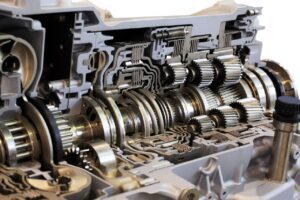
How Does A Semi Truck Transmission Work
A semi-truck’s transmission is crucial for optimal performance. It directly influences the vehicle’s power, speed, and efficiency so how does a semi truck transmission work.
This will explain how semi-truck transmissions work, discuss the different types available, and provide tips for identifying how many gears your truck has and go over so how does a semi truck transmission work.
How Semi-Truck Transmissions Work
The transmission is the vital link. It contains a complex system of gears that regulate engine power, allowing the truck to:
- Accelerate from a standstill
- Change speeds smoothly
- Handle varying terrain
The transmission works in conjunction with several parts, including the clutch, drivetrain, and driveshaft, to deliver the necessary power to the wheels.
How to Tell How Many Gears Your Semi-Truck Has
The simplest way to know your semi-truck’s gear count is to check the gear shifter (for manual transmissions) or the manufacturer specifications.
| Feature | Description |
|---|---|
| Purpose | Transfers power from the engine to the wheels, allowing for acceleration, speed changes, and terrain adaptation. |
| Key Components | Transmission (gearbox), clutch, drivetrain, driveshaft |
| Determining Gear Count | Check gear shifter (manual), sun visor, or owner’s manual |
Here are common locations for gear information:
- Gear Shifter: A diagram usually displays the number of gears.
- Sun Visor: Some trucks have the gear count listed above the windshield.
- Owner’s Manual: Refer to your truck’s manual for specifications.
Types of Semi-Truck Transmissions
Semi-truck transmissions come in three main categories:
- Manual: The traditional type, requiring the driver to shift gears manually. These can have up to 18 gears.
- Automatic: A more modern option, offering automatic gear shifting for easier operation.
- Automated Manual: Combines aspects of both manual and automatic transmissions for smooth operation and potential fuel savings.
| Transmission Type | Description | Pros/Cons |
|---|---|---|
| Manual | Driver shifts gears using clutch and gear shifter | More control, potentially cheaper / Requires more skill, can be physically demanding |
| Automatic | Shifts gears automatically | Easier to drive, less wear and tear / Can be less fuel-efficient in some cases |
| Automated Manual | Combines manual and automatic features | Smooth shifting, potential fuel savings / More complex, can be more expensive |
Manual Transmission Subtypes
For a deeper dive, here are common subtypes of manual transmissions:
- Splitter: Gears split into high and low ranges for flexibility.
- Range: Works with high and low gear ranges within the H-pattern
- Range-Splitter: Blends range and splitter concepts for the greatest versatility
| Subtype | Description |
|---|---|
| Splitter | Gears split into high/low ranges for flexibility |
| Range | High/low gear ranges within an H-pattern shifting system |
| Range-Splitter | Combines splitter and range concepts for maximum versatility |
Sources
Allison Transmission (https://www.allisontransmission.com/): Another major transmission manufacturer, specializing in automatic transmissions for commercial vehicles.
Conclusion
Understanding how does a semi truck transmission work is essential for ensuring safe and efficient operation.
Whether you have a modern automatic or a classic manual transmission, knowing how the gears function will help you get the most out of your truck.
We hope you enjoyed this post on How Does A Semi Truck Transmission Work let us know in the comments below what you think.